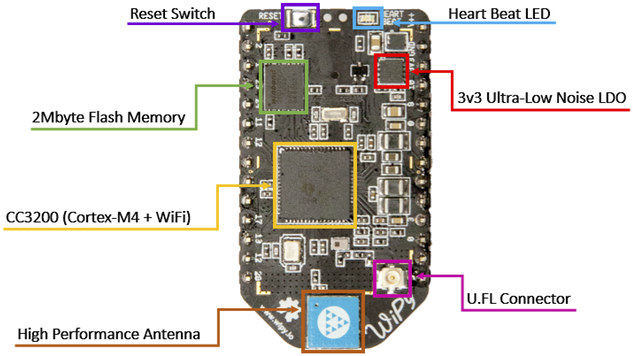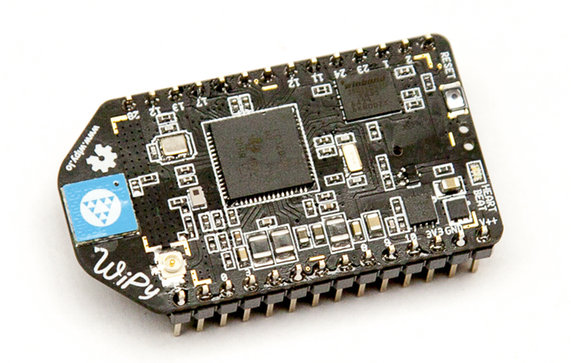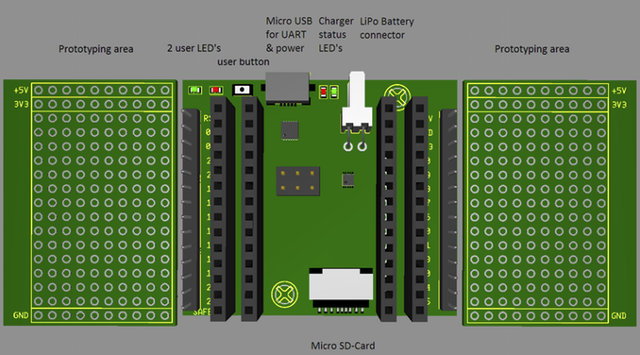If you’ve interested in connecting devices via Wi-Fi, you’re being spoiled as “Internet of things” boards keeps getting designed and produced. The latest board with WiPy, a small board powered by Texas Instruments CC3200, running MicroPython, and consuming less than 1mA in suspended mode with Wi-Fi connected.
- MCU – TI CC3200 ARM Cortex-M4 @ 80 MHz with 256KB RAM, Wi-Fi and TCP/IP stack
- Storage – 2MB flash
- Connectivity – WiFi 802.11b/g/n 16Mbps (AP, Station and WiFi-Direct), on-board antenna and u.FL connector
- Expansion – 2x 14-pin headers (2.54mm pitch) with
- Up to 25 GPIOs
- 2x UART, SPI, I2C, I2S, and SD card
- 3×12 bit ADCs
- Others
- 4×16 bit timers with PWM and input capture
- RTC
- Hash and encryption engines: SHA, MD5, DES, AES
- Reset switch, heartbeat LED
- Power Supply – 3.6 – 5.5V DC input; 3.3V output up to 250mA
- Power Consumption – Active: 14 mA; Suspended (Wi-Fi connected): 850 uA; Hibernating (No Wi-Fi): 5 uA
- Dimensions – 25mm x 45mm (1.0″ x 1.77″)
 Beside low power consumption, the board can switch from suspended to active mode in less than 5 ms, send some data, and go back to sleep, with the developers claiming several years on a single battery charge with this type of activity.
Beside low power consumption, the board can switch from suspended to active mode in less than 5 ms, send some data, and go back to sleep, with the developers claiming several years on a single battery charge with this type of activity.
The board run MicroPython and so it can be programmed using Python 3.4, minus some functions like “with” or “yield from”. You’ll notice no USB port on the board that can be used for programming, that’s because you’d normally connect via Telnet to access the console, and program the board from there, and alternatively you can also connect via FTP to upload Python scripts or other files. WiPy supports BSD sockets, and MicroPython compatible librairies are being worked on to handle HTTP, SMTP, XMPP, FTP, and MQTT, and since the TI MCU also support hardware hash and encryption, secure HTTPS and SSL connection will also be available.

There aren’t any shields for WiPy, as it’s breadboard compatible so you can easily connect it to your existing modules for your project, but they’re still in the process of developing an expansion board with a micro USB and battery connectors, FT234XD USB to serial converter, a LiPo charger, a micro SD socket, two prototyping areas, and more.
MicroPython source code for CC3200 is already available on WiPy github account, and the hardware files are being promised once the project is about to ship.
WiPy has just reached its 30,000 Euros target on Kickstarter, where you can pledge 27 Euros to get WiPy with the headers of your choice (male, female, double stackable, or none), or 37 Euros to also include the expansion board above. Shipping is included, and delivery scheduled for August 2015. You can find more details, ask question on their forums, and soon access tutorials on www.wipy.io.

Jean-Luc started CNX Software in 2010 as a part-time endeavor, before quitting his job as a software engineering manager, and starting to write daily news, and reviews full time later in 2011.
Support CNX Software! Donate via cryptocurrencies, become a Patron on Patreon, or purchase goods on Amazon or Aliexpress







…Or just buy an ESP8266 module for one-tenth the price of this overpriced thing
Yeah, buy ESP8266 and bang your head against it – without proper documentation, support, technical specs, with questionable licensing (current tools many people use are on the brink of legality, and if you want to sell a product based on ESP8266, you likely cross the border). All that is seriously exciting stuff, I’m doing that for half-year already and suggest everyone drop everything and start hacking on ESP8266 – I estimate if we all pull together, in a year we have something similar to a module from a reputable western vendor like used in this WiPy thing. There still will… Read more »
How does the tcp/ip stack work on this and/or the ESP8266?
For example, do you get low-level control to implement any protocol you want (ftp, https, telent, etc).. or are you limited to whatever services the serial commands support?
Or is the idea that you implement a stack (uip, lwip, etc) on top of whatever hooks they provide? I’ve seen freertos has been ported to the esp8266, so I imagine that’s the case?
https://github.com/beckdac/ESP8266-transparent-bridge
@Abdullbasit I think the main advantage of WiPy over ESP8266 is the lower power consumption. If you check ESP8266 power consumption table @ https://nurdspace.nl/ESP8266#Ultra-low_power_technology, you’ll find power used during Tx / Rx is much higher. I’m not sure how to compare standby / suspended mode between the two since they use different terminology. So if you have a battery operated system, WiPy will be better, and possibly cheaper because you won’t need to charge / replace the battery as often. @ben I understand the low level parts such as TCP/IP are implemented in hardware (MCU ROM), and can you implement… Read more »
@Paul
Who cares if it’s Western or eastern ? It’s very cheap and hackable and very popular and I’m sure it will soon Make all iot manufacturers sleep with one eye open because none will provide anything with such a performance/price
@Paul Where is this “brink of legality” coming from? The xtensa tools are open source. And yes, not all of the firmware for the esp8266 is open source, but Espressif is under no GPL obligation to provide the source. What is this legal issue you are inferring? The chips are aimed at different markets. CC3200 has been designed with batteries as it target. ESP is not very good on batteries, but it is extremely cheap when you have plenty of power around. And at $8 a chip I don’t see the CC3200 ending up in LED light bulbs which is… Read more »
The wifi solution spectrum looks like this…
Price is approximate for complete module production (not retail)
lowest cost – ESP, $2, no Linux
lowest cost Linux – RT5350/AR9331/MT7620, $6
best battery – CC3200, $10, no Linux
full Linux – Allwinner A33, ralink USB wifi, $10-12, tablet PCB
then there are many more entries at higher price points
If you want the battery to last over a year – Bluetooth LE, 802.15.4, proprietary – $3
> but Espressif is under no GPL obligation to provide the source. They’re not under GPL obligation, you are. Because their license is GPLv3 with the title changed, it requires you to release complete source if you combine it with their stuff to form a single product. Moreover, it requires you to release to your customers on demand the source which they don’t provide, but you should. At this point many GPL violators start to spread FUD about system library exceptions, etc. which are just that – lies and FUD. The point is – companies who don’t want problems for… Read more »
@Paul I just downloaded the latest Espressif SDK. The license looks like a hacked up GPLv2, not GPLv3. None of the GPLv3 stuff about patents and encryption keys is there. After reading through that license it appears to have some problems. Pieces of text have been removed from the body and not from the preamble which makes it a mess. I have contacted the CEO of Espressif about fixing it. Looks to me like they are trying to be open with the SDK but they are confused about how to make a proper Western style license. They probably want a… Read more »
I’d say there is not that much difference between ESP8266 at the moment and when TI and Nordic released their early BLE chips – poor support for everyone (and docs/software with errors) .
Are TI’s BLE chips still 8051 based or do they finally have an arm based ble ?
For wipy are there any security features ?
Using telnet/ftp for programming doesn’t sound good(securitywise)
@Jon Smirl > The license looks like a hacked up GPLv2, not GPLv3. None of the GPLv3 stuff about patents and encryption keys is there. IIRC, when I compared texts, it looked like v3 was a template, but it definitely was redacted a bit. Anyway, I’m glad you confirm you see the similarity. > They probably want a variation of the MIT license, not the GPLv2. I will let you know what he says. Yes, having a liberal license like MIT or BSD is what was suggested, and argued in length at https://github.com/espressif/esp_iot_rtos_sdk/issues/1 (sorry, in last comments it went into… Read more »
@Jon Smirl (I replied on Espressif licensing situation in previous comment, it so far waits for moderation.) > nRF24LE01+ — single vendor is a downside. Well, essentially any non-linux module is a “single vendor”, as they offer their own adhoc APIs. At least some vendors (like TI) have core connection functionality based on BSD sockets, while some other (like Espressif) try to push their own proprietary APIs. But back to nRF24LE01+ – come on, you can’t not know about Beken BK24xx (BK2421, BK2433)! These are Chinese clones of nRF24 series, with bits of original research. Thanks to these “Chinese friends”,… Read more »
@Paul Espressif CEO has received my comments on license. Maybe we will have something tomorrow.
As for nRF24 – I knew about the transceivers, I was listing SOCs above. I didn’t know that Nordic had made a nRF24 SOC – nRF24LE1+.
TI has some impressive power numbers with the CC2640. They made it dual core with one core being very simple and low power. The simple core monitors to peripherals and then wakes up the bigger core when there is something to do.
Another area are the 433Mhz chips. Are there any 433Mhz SOCs? There are multiple transceivers.
@Jon Smirl > Espressif CEO has received my comments on license. Maybe we will have something tomorrow. Thanks! > TI has some impressive power numbers with the CC2640. My personal opinion on CC2640 is that it’s actually a response to things like ESP8266 – TI finally stopped releasing just bugfixes of previous generation as a new product, and did something really innovative. There’re actually 3, not 2 cores. And lot of that stuff is actually documented, unlike for example CC3200. > Another area are the 433Mhz chips. Are there any 433Mhz SOCs? There are multiple transceivers. Nordic had nRF9E5 for… Read more »
@Jon Smirl
CC1110/CC1111 are decent low power SOCs for 443/868/915MHz although they use 8051 not ARM cores.
Espressif got back to me. They will change SDK to MIT to match RTOS. Updated SDK should be out in a day or two.
There was never any intention here to force a viral license, it is just general confusion about what kind of license is needed for Western developers. Everyone was telling them that GPL is good, but then they didn’t consider the effects of applying the GPL to the SDK where MIT was actually needed.
@Jon Smirl Great news, looking forward to it, including to restart work on few projects which were in backlog due to this unclear licensing situation. > There was never any intention here to force a viral license, it is just general confusion about what kind of license is needed for Western developers. I did hope so, and from my side tried to show and explain them the difference, to avoid a situation when one random guy just tells them to do one thing, another tells to get it back, and 3rd to use something else altogether. Hope that thru such… Read more »
I stumbled onto a Chinese Bluetooth chip from Chipsea.
http://www.chipsea.com/html/product/ble/201408/1388.html
Maybe some one in Shenzhen can talk to them and tell us how much it is. There is zero English on the Chipsea site.
CSE7758 also looks interesting.
Espressif has not updated SDK yet, I will bug them again in a few days. CEO has agreed to change, it just hasn’t filtered down the ranks yet.
@Jon Smirl
> Espressif has not updated SDK yet, I will bug them again in a few days. CEO has agreed to change, it just hasn’t filtered down the ranks yet.
Sure, which company could do it in a matter of days? ;-). My plan would be to ping you so could ping them if there’s still no changes within 2 weeks.
@Jon Smirl
I don’t have the price in quantities, but a CS3510 Bluetooth module sells for 15 RMB ($2.4) on Taobao @ http://item.taobao.com/item.htm?spm=a230r.1.14.1.K9Wy28&id=42079181356&ns=1&abbucket=5#detail
I also checked Bluetooth module on Aliexpress,. The cheapest one (HC-05) costs $0.95 http://www.aliexpress.com/item/Free-Shipping-Interface-Base-Board-Serial-Transceiver-Bluetooth-Module-HC-05-06-For-Arduino-For-Sale/32216899618.html
Based on CSR chip, which only support Bluetooth 2.0 + EDR -> https://developer.mbed.org/users/edodm85/notebook/HC-05-bluetooth/
For Bluetooth I would stick with the main stream stuff. Here’s a TI CC2540 based module for 17 RMB.
http://item.taobao.com/item.htm?spm=a230r.1.14.80.r7flz8&id=40505575489&ns=1&abbucket=7#detail
I tried translating the Chipsea documentation and it appears that their chip only does BLE slave mode. Slave is fine for a peripheral like a temp sensor.
nRF51 is an excellent chip with open source tools. 18RMB
http://item.taobao.com/item.htm?spm=a230r.1.14.13.qHFqAS&id=44210242098&ns=1&abbucket=7#detail
@Jon Smirl
So, 2 weeks has passed since Apr 27, when you shared response you got from Espressif officials on licensing issue. No SDK release with updating licensing was made. During this period, they released patch for SDK 1.0.1, so it’s not the case they have someone working on SDK releases just from time to time – the work is ongoing, and they apaprently can release updated SDK anytime. But so far they didn’t. So, can you please contact them again for a status update? Thanks!
I asked a couple days ago, CEO says it is in process and his people are working on it. You were right that they wouldn’t be able to do it immediately.
Thanks for the update.
@Jon Smirl Last Friday, May 22, Espressif released SDK 1.1.0, still with the same license file. In few days, there will be a month since Jon Smirl’s inquiry to them (and 3+ months since my own inquiries). Even monsters like TI or Broadcom would do a change in such time, if they wanted. So: Conclusion #1: Espressif doesn’t keep promises, even such obvious/important one like clarifying a license. Moreover, it would be easier to either change it, or say they won’t change it, but instead they make falsy promises. Also, I don’t buy that they don’t understand open-source licensing. Their… Read more »
Today ESP8266 SDK 1.1.0 was re-released under MIT license: http://bbs.espressif.com/viewtopic.php?f=5&t=481 . Thanks to everyone involved!
https://github.com/pfalcon/esp-open-sdk was updated to the MIT SDK release (and also fixed an easily fixable backward incompatible change in SDK 1.1.0).